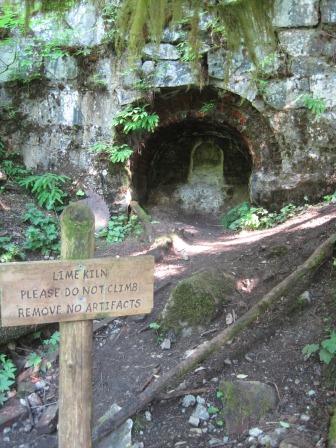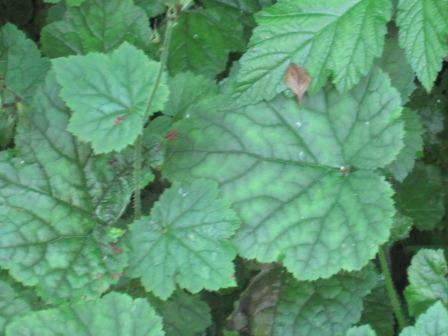Or possibly something else?

Answer Monday!
I’ve been to Chicago before, but mostly on business. It always seemed nice though, so, last week I went with my family and, for the first time, I had the chance to look at some of the sights. Navy Pier – overrated. Shedd aquarium – met expectations. Chicago style pizza from Giordanos – so much better than I expected. Chicago hotdogs – damn good, but not equal to Chicago pizza. The Field Museum – TERRIBLY UNDERRATED. I just loved the Field museum. There were all kinds of fantastic displays on everything from whales to evolution. There was also a great display on plants. The information in the display was spot on, but this was definitely one of the simpler displays at the museum. In fact, to be honest, it seemed a little bit like the display cases were made in the 1950s or 60s. That said, there was a lot of room for the display to spread out across, after all, this is, supposedly, a major attraction for the museum.
The thing is, no one was there. It was freaky. My wife was taking the kids to another display hall (one more suited to younger kids where they could actually play with stuff), and so I went to the plant display by myself. My feet echoed across the halls as I walked down the corridor. When I turned around to look at the direction from whence I came it felt like a movie where I was walking in a hallway from the fifties and everyone outside was hustling and bustling in the 21st century. When I turned a corner in the hall there was a guy apparently passed out over his laptop. This was the only living person that I saw while visiting the display — and he obviously had no interest in plants – at least not when I saw him (Truth is, for all I know he was dead. The next day I felt guilty for not checking his pulse to make sure he was really alive). And, based on this photo from someone on flickr, I’m not the only one who has seen this exhibit empty.
Is this the interest that people have in plants today? How sad. No wonder we’re losing horticulture departments. But on a livelier note, I’ve been such a downer the last few posts that I promise I’ll provide something a little happier next week!
Blog reader Shawn sent this link to me yesterday. It’s a pretty short take on a complex topic, but even so I was troubled by the perception that all nuisance weed species are our own fault.
Sure, it’s true that humans have moved plants or plant parts around with them for centuries. Sometimes it’s been deliberate, and sometimes it’s been accidental. But other animals also move plants around, especially seeds. When we draw this kind of distinction between what we do and what other animals do, philosophically we are removing ourselves from the natural world. True, we have technology and all kinds of other human inventions, but as a species we are still part of the biosphere.
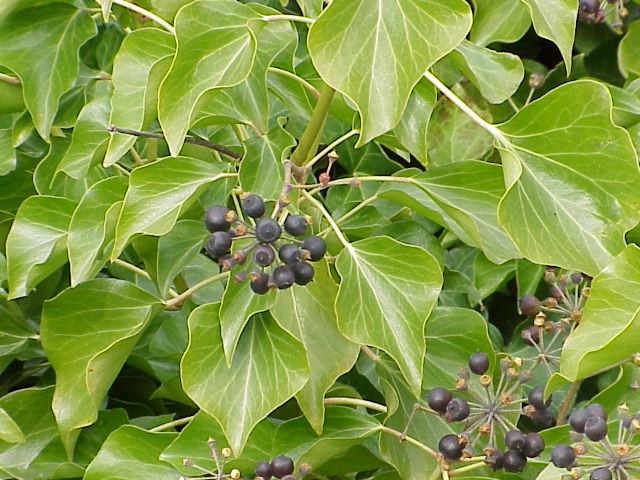
Ivy’s little dispersal units – spread by birds
Philosophical issues aside, there’s another part of this blithe acceptance of weedy species that concerns me. Though plants take advantage of animals as a means of dispersal, the rate at which nonnative, weedy species are spreading and colonizing new environments is unprecedented (this is where technology comes in). Ecosystems can adapt to new species and other environmental challenges – but when the rate is accelerated, the adaptive process is impaired. Thus, some native species go extinct when the rate of change is too great.
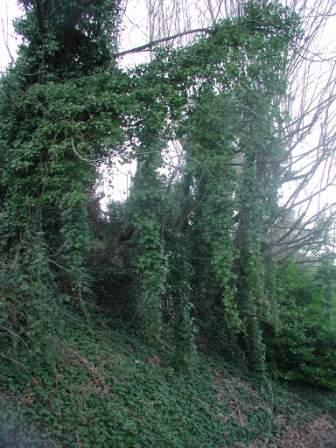
Ivy left to its own devices in a natural area
These are basic ecological concepts – and we ignore them at our own peril.
Just back from the national OFA Floriculture short course and trade show in Columbus, Ohio. There was quite a buzz (!) over the July cover story of the industry mag GrowerTalks:
Maybe, if there’s a variegated form…
GrowerTalks is NOT High Times. Commercial floriculture is a very, very conservative industry. Many family businesses. New petunia cultivars and seed-sowing technologies are the usual fodder for feature stories. But as a publication reaching out to people who grow plants under glass (or plastic) for a living, GrowerTalks has brought up a good point. As article author Jennifer Zurko points out, there are now 16 states where medical marijuana is legal, and many more have it under consideration. The average margin on wholesale bedding plant production is around 1.3. My guess is marijuana might do a little better than that. “Legal” sales in California are projected at $1.3 billion for this year. The entire U.S. Floriculture industry (wholesale value) is worth $4.3 billion currently.
Floriculturists are the preeminent controlled-environment specialists. Example: a grower takes an Easter Lily through 24 weeks of vernalization and bench production from bulb to buds, maintain a 2.6:1 plant:pot height ratio, and hits what is essentially a 5-day market window that changes yearly. Marijuana would be a comparative walk in the park.
Jennifer does a great job describing the caveats and issues, both technical and moral. Not least of which is that marijuana is, of course, illegal in the eyes of the federal government. But someone’s going to grow it. Heck, Scott’s Miracle Grow is already working on water-soluble fertilizer specific to the crop.
I’ve been continuing to track some of the reports of injury to conifers associated with the new herbicide, Imprelis. Interest in the problem is likely to escalate given a front page article in the Sunday’s Detroit FreePress. http://www.freep.com/article/20110710/NEWS06/107100467/New-lawn-chemical-chief-suspect-mysterious-deaths-trees
I visited about ten sites last week with an applicator that had used Imprelis this spring. The landscaper was a certified applicator with about 15 years of experience with herbicides, insecticides and fungicides, who was knowledgeable about his chemicals and plants. We saw bout 50 trees, mostly pines and spruces with varying levels of injury. The typical symptoms were brown or off-color needles, and stunted or twisted shoots. Damage was mostly limited to the current flush of growth, resulting in a distinctive pattern of growth. In many cases, there was evidence of spiral movement up the trunk of the tree. The most rapid growing points (usually terminal leaders) were most severely affected. Based on my experience with other forms of herbicide injury and other types of environmental damage, I suspect all but the most severely injured trees would recover is given enough time and some corrective pruning. The problem, of course, is that most homeowners don’t want to wait around while the tree in their yard tries to rally.
Some photographic ‘highlights’






The $64 question now becomes, “What happened?” In order to receive registration from the US EPA, each new herbicide has to go through extensive testing. According to DuPont, over 400 tests were conducted with Imprelis. Despite some claims elsewhere on the internet, this testing included independent university trials on spruces and pines at up to 4x the labeled rate. The key to unlocking the mystery of Imprelis injury will probably lie in understanding how conditions in actual application conditions differed from the testing.
Today I was sent a link to a posting on “droopy leaves.” Essentially, it suggests that droopy leaves are a means to conserve water on hot days and that watering these plants causes more problems than it solves because the roots don’t get enough oxygen. A link to the science of transpiration is provided. The advice is to wait until the evening and if the plants perk back up, then they didn’t need water after all.
This is one of those maddening articles that has enough science in it to make it sound reasonable, but is ultimately incorrect in its assumptions and advice. It’s worth looking at the topic in a little more detail.
Some plants are adept at conserving water in hot weather. Their leaves tend to be small, thick, with a heavy layer of waxes protecting the surface. Leaves can also move to limit their sun exposure and thus reduce the heat load. But wilting is not a method of conserving water. Instead, it’s a sign that water loss (evapotranspiration through the leaves) exceeds water uptake from the roots. And if you ignore wilt, you do so at your own peril. Once terminal wilt is reached, it’s all over for that part of the plant.

Wilt. Sorry it’s a fuzzy photo.
Large, thin leaves, common in many of ornamental, annual and vegetable species, do not conserve water. Tomatoes, zucchini and black-eyed susans, the plants specifically mentioned in this article, are not water conservers. Chronic wilting of these and other can eventually cause leaf tip and margin necrosis (or tissue death). It also reduces growth, so that your yield of tomatoes, zucchini and black-eyed susans will be decreased.
 Leaf tip and marginal necrosis from chronic drought stress
Leaf tip and marginal necrosis from chronic drought stress
So yes, do water your plants if they are wilting in the midday heat! Use mulches to conserve water! (You’ll notice in the photograph on the linked site that the plants are in bare soil.) Fine root systems are generally near the soil surface, and keeping these hydrated keeps them alive. You won’t see an instantaneous response to watering if plants are already wilting, but they will recover – much better than if you don’t water them at all.
Sorry about the long wait in discussing the weekend’s post! (Technical troubles with access here in BlogVille.) In any case, many of you zeroed in on the defunct lime kiln as a possible pH adjuster. It would have been really interesting during those years to see how materials were processed – for instance, was there a lot of lime dust that settled over the area? Where did the limestone come from – was it carted in by train or was it local? Were chlorosis problems visible then?
In any case, my educated guess is that a lot of limestone chunks brought to the area for processing were left scattered around the site and were eventually buried over time. Plants recolonized the area, but where these chunks of limestone are sited we have pockets of chlorosis. The only way to tell for sure would be to test the soil pH, and I did not have pH strips in my backpack.
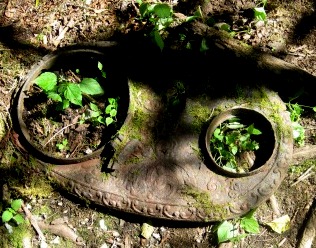
It’s high season at our blueberry farm. Each morning, the yard fills with cars (at 7:00 a.m. – aargh) and eager blueberry pickers hit our four acres of Northern Highbush berries. No late freezes, lots of hard work by our honey bees, and good rainfall have added up to a blockbuster crop. Certainly helps with the mortgage.
Running a you-pick ( U-Pick makes me itch) farm is an …interesting experience. Upside – you do the picking, we weigh the buckets, we take the money – $2.40/lb + tax. Very reasonable for big, fat berries. Our average sale is right around 10 lbs. I’d (theoretically) invite 90% of our customers to stick around for dinner – they’re that nice. Downside, besides hot, grumpy children, bee stings, and porta-potties: some people literally eat their way across the field. We absolutely expect pickers to taste a few as they go. That’s part of the you-pick experience. But I have witnessed some remarkable acts of blatant face-stuffing. Kids, I can kind of understand, but adults? I mean, do you eat your way through the produce section of the grocery store? The truly noble customer recognizes this and offers an extra dollar or two (“Gosh, I may have eaten a lot”). But the clueless #%$& who eats with both hands for an hour and then pays for a pound makes us a bit queasy. We get reports all the time from concerned customers i.e. “See that guy in the brown hat? He’s eating more than he’s picking.” One incident that comes to mind is a lady that completely denuded a 6′ plant; encouraging her daughter to eat the whole time, and then paid for less than a pound.
We try not to sweat it – maybe it’s a compliment as to how good our blueberries are – but it still puzzles me. What am I missing here? Why is this acceptable? Taking a tip from another local farm, we put out a jar near the register last week. They call it a “sin jar” but that’s a little too judgmental for us. We call it “munch money” and note that the contents of the jar goes to our local woefully-underfunded animal rescue and shelter. We make a donation yearly anyway; now it’s more fun (and satisfying), served up as a gentle nudge – we raised $120 for the shelter over the 4th of July weekend alone!
Today my family took our annual 4th of July weekend hike. We ended up on a fairly new trail through the Robe Canyon Historic Park. It was a gorgeous day and we saw all manner of plants and animals. The highlight of this trail is an old lime kiln; bricks and other remnants of early settlers are scattered around the area. The kiln closed in the 1930’s. (The hot link embedded in the park name leads to a 2004 article about the trail and the history of the site.)
